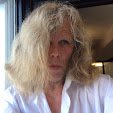
Scott Lord on the Silent Film of Greta Garbo, Mauritz Stiller, Victor Sjostrom as Victor Seastrom, John Brunius, Gustaf Molander - the Golden Age of Swedish Silent Film........Lost Films in Found Magazines: Victor Seastrom directing John Gilbert and Lon Chaney, the printed word offering clues to deteriorated celluloid, extratextual discourse illustrating how novels were adapted to the screen; the photoplay as a literature, a social phenomenon; how it was reviewed, audience reception.
Scott Lord on Silent Film

Gendered spectatorship notwithstanding, in a way, the girl coming down the stairs is symbolic of the lost film itself, the unattainable She, idealized beauty antiquated (albeit it being the beginning of Modernism), with the film detective catching a glimpse of the extratextural discourse of periodicals and publicity stills concerning Lost Films, Found Magazines
Tuesday, July 15, 2025
Scott Lord Silent Film: Linda Arvidson in The Adventures of Dollie (D.W....
Actress Linda Arvidson, writing in the periodcial Film Fun during 1916, includes the "now historic" film "The Advntures of Dollie" (one reel) directed by D.W Griffith for the Biograph Film Companyin 1908. Arvidson wrote under the name Mrs. D.W. Griffith. In one installment she reminisces about travelling to film exterior scenes, claiming they hadn't automobiles yet and visited locations by train or by boat. In a later installment she dicusses her salary for the film, "How much money I made! Twenty eight dollars in two weeks, enough for a whole spring outfit." What is more enjoyable is the autobiography of Mrs. D.W. Griffith, When Movies Were Young, published in 1925. Much of the material from the Film Fun periodical is repeated, worded similarly, as she gives an account of D.W. Griffith the actor being offered a provisional chance to direct his first film, "The Adventures of Dollie", given that he could return to acting if necessary. Mrs. D.W. Griffith exlains Griffith having been accepted as a director for Biograph, "For one year now, those movies so covered with slime and so degraded would have to come first to come first in his thoughts and affections....agonizing days when he would have given his life to be able to chuck the job." She includes not only the studio on East Fourteenth Street but the theaters on Third and Ninth Avenues as places into which one would not be seen going.
Author Edward Wagenkneckt, in his volume The Films of D.W. Griffith, chronicles that 'The Adventures of Dollie", filmed in July of 1908, was the first of 450 films directed by D.W. Griffith for the Biograph Film Company before leaving in September of 1913 all but eleven having been one reelers. Author Roger Manvell, in his sixty page introduction to the anthology "Experiment in the Film" credits "The Adventures of Dollie" as the first film in which D.W. Griffith had used the flashback.
Peter Cowie, in his volume Eighty Years of Cinema, notes that it was in 1908, in the film "For Love of Gold", that D.W. Griffith had first used the close up shot in film.
In regard to my webpage series "Lost Films, Found Magazines", begun at a time when film preservation was unearthing many unseen masterpieces from the silent era, author Tom Gunning, in his volume D.W. Griffith and the origins of American Narrative Film, lends a caution that supports the premise of needing a film history detective while dismissing the perfect accuracy of historiography and the endeavor. "The accounts of Griffith's biograph films given by Lewis Jacobs, George Sandoul and Jean Mitry are filled with descriptions that do not correspond with the actual films. Based primarily on written descriptions rather than on the films themselves, these eroors are recycled in textbooks on film history." Gunning cites in particular the autobiography of the wife of D.W. Griffith, Linda Arvidson. According to Gunning, the point of departure used by Lewis Jacobs was primarily the editing that Griffith employed; while looking at Terry Ramsaye and his analysis of shot structure, Gunning adds the phrases "screen grammar" and "pictorial rhetoric" to the familiar "syntax of film narration". "For Sandoul, Griffith's stylistic innovation shattered the theatrical unity of space by introducing the ubiquity of the camera and a unity of action." Gunning also advances the semilogical analysis of Christian Metz as a review of Griffith at Biograph having brought a "liberation of film from theatrical tradition" with the creation of a "film language.", the cinema of attractions bringing new "codified constuctions" to accomadate the cinema of narrative integration, "syntagmas in which individual shots depend on their relation to other shots in the chain for their meaning." Tom Gunning writes, "Dollie's story forms a perfect match with Todorov's "minimal complete plot" although Griffith structures the story through a "spatial as well as narrative circuit". Gunning is referring to the writing of Tzvetan Todorov on narrative equilibrium, progress and resolution who places plot among the elements of narrative, which also include characters, point of view, setting, theme, comflict and style.
Arthur Knight, in his volume The Livliest Art gives one summary of the importance of D.W. Griffith, "He created the art of the film, its language, its syntax. It has often been said that Griffith 'invented' the close-up, that he 'invented' cutting, the camera angle, or the last minute rescuse...He refined these elements already present in motion pictures."
Silent Film D.W. Griffith D. W. Griffith
Greta Garbo Victor Sjostrom Silent Film
Scott Lord on Silent Film, Scott Lord on Swedish Film, Scott Lord on Mystery Film
at
11:19:00 PM
Greta Garbo Victor Sjostrom Silent Film
D W Griffith,
D. W. Griffith,
Silent Film Biograph Film Company
 Scott Lord on Silent Film, Scott Lord on Swedish Silent Film, Scott Lord on Danish Silent Film
Scott Lord on Silent Film, Scott Lord on Swedish Silent Film, Scott Lord on Danish Silent Film
Subscribe to:
Post Comments (Atom)
No comments:
Post a Comment